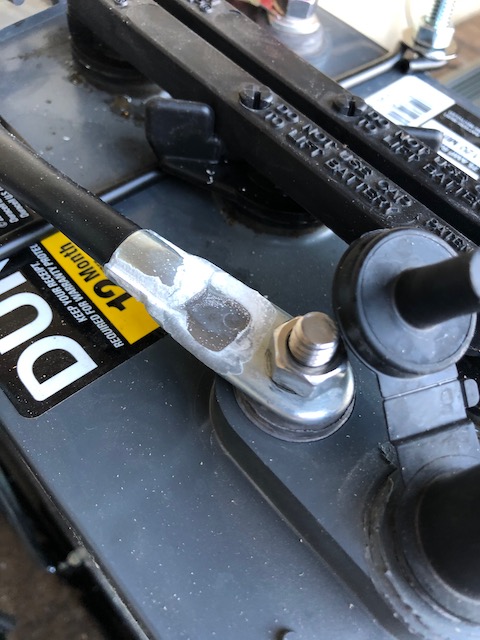dixonge
Well-known member
Problems in the order that I can remember them:
1 - When I charge my laptop, the 1500w inverter gets warm and the fans kick in. This stops within 5 minutes after I unplug the laptop
2 - Last night we went from full charge to somewhere around 20% before we went to bed. Fridge is on gas. We had a new cellular modem hooked up and running and a couple of LED lights. That's about it. I'm sure we were using *more* electricity the first few nights we had the solar hooked up, but last night just drained everything. I heard the inverter's fault/error beeping so turned it off and switched over to the original house batteries.
3 - Double-checked water levels this morning, topped them off. Noticed some corrosion around the negative post on one battery, where the cable connects to the positive terminal of the other battery. The corrosion is just on the cable lug, not the terminal. (see pic) Both batteries have been connected and used less than 10 days.

I'm truly perplexed. I guess it *could* be the new cell modem, but I'm suspecting the one battery. It was low on water when we first got it, but I filled it before I connected it. It tested fine. But now I'm having second thoughts.
So I appreciate any thoughts you may have. Thanks in advance.
1 - When I charge my laptop, the 1500w inverter gets warm and the fans kick in. This stops within 5 minutes after I unplug the laptop
2 - Last night we went from full charge to somewhere around 20% before we went to bed. Fridge is on gas. We had a new cellular modem hooked up and running and a couple of LED lights. That's about it. I'm sure we were using *more* electricity the first few nights we had the solar hooked up, but last night just drained everything. I heard the inverter's fault/error beeping so turned it off and switched over to the original house batteries.
3 - Double-checked water levels this morning, topped them off. Noticed some corrosion around the negative post on one battery, where the cable connects to the positive terminal of the other battery. The corrosion is just on the cable lug, not the terminal. (see pic) Both batteries have been connected and used less than 10 days.
I'm truly perplexed. I guess it *could* be the new cell modem, but I'm suspecting the one battery. It was low on water when we first got it, but I filled it before I connected it. It tested fine. But now I'm having second thoughts.
So I appreciate any thoughts you may have. Thanks in advance.












































































